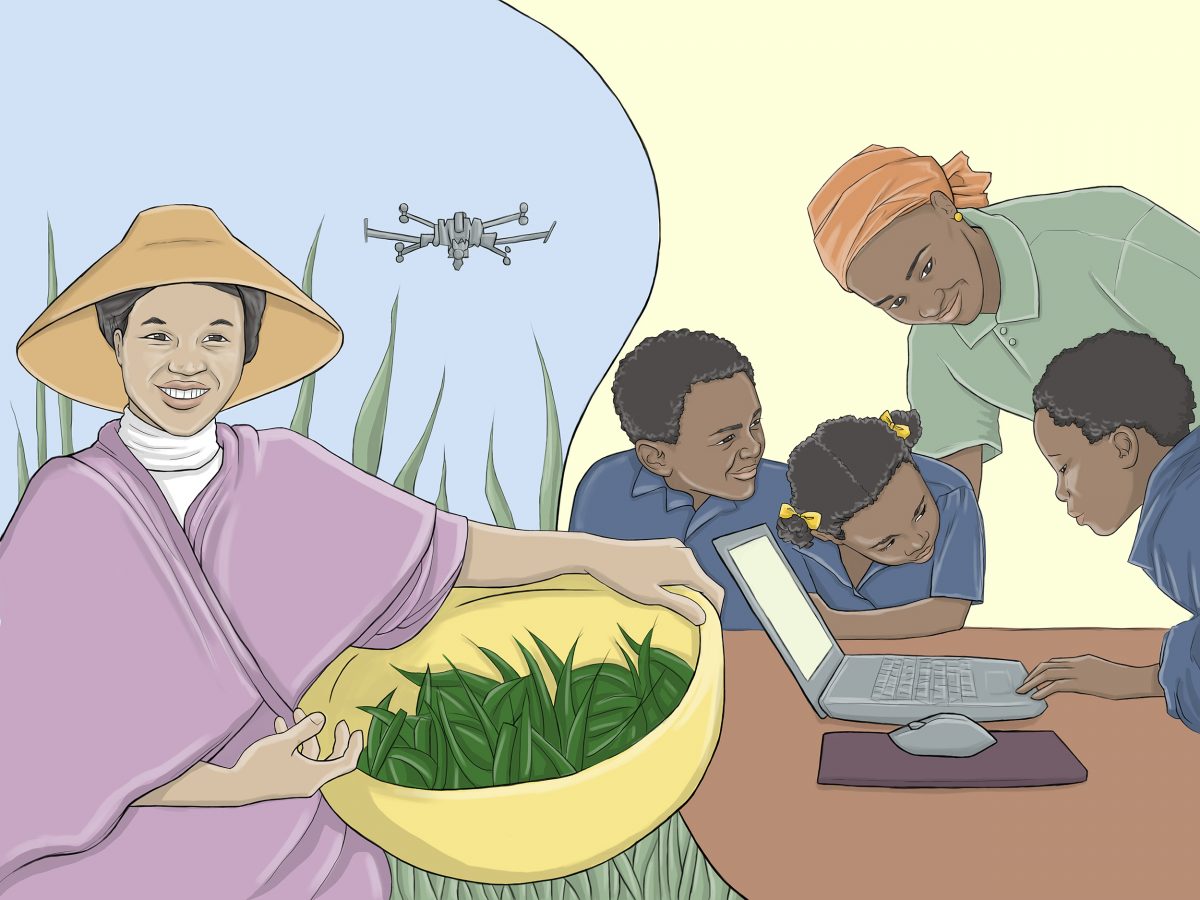
Utopian visions of the future have come a long way since science fiction entertainment crept into the mainstream with the original Star Trek, first broadcast in 1965, or 1968’s Barbarella. But today’s media still clings to visions of tomorrow where technology takes away all our mundane tasks.
That vision goes something like this: Our protagonist wakes in their sleek, clean mansion. An AI-powered home assistant announces their itinerary for the day. They don wearable tech, which suggests their ideal breakfast, then climb into their emissions-free self-driving car. The vehicle whisks them away while they chat with contacts over an ultrafast communications network.
This utopia could easily be a reality for some in our lifetime – parts of it already are. But what about those living in poverty? Will the future see the most economically vulnerable cast out into a technological wilderness?
Tech and economies reliant on primary production
Technology’s evolution asks awkward questions about societies with troubled economies, especially those reliant on high-energy input, low-value output sectors. As global population has grown, technology development has accelerated. The UN says the world’s population will increase to 9.7 billion by 2050 and peak at nearly 11 billion by 2100.
Population growth is fastest in economies most reliant on sectors that could be most affected by automation, like mining, manufacturing and agriculture. We could see more people competing for fewer jobs, worsening poverty and putting new technologies further out of reach.

Kaspersky cybersecurity training
Defend your organization
Give employees the knowledge to fight cyberattacks
James Dening, Senior Vice President for Europe, the Middle East and Africa at AI specialists H20.ai, discusses how technology changes work patterns. He says job automation is nothing new but recognizes it’s increasingly moving beyond manual roles.
“We’ve spent less time on some activities. Whole roles and jobs have gone,” he says. “A farm that employed 15 people decades ago now employs two to three. Secretarial roles have declined as productivity suites like Microsoft Office have become the norm. Self-service for workplace activities has become rule rather than exception. The new wave of workplace automation technologies will do the same thing.
“We’ll look back and say, “Hey, remember when we had people doing Accounts Payable instead of automation with some machine learning for the hard bits and a little human oversight?” It doesn’t mean people will lose their jobs, but jobs will change.” A counter to the ‘machines will take our jobs’ argument (sometimes called the Luddite fallacy) is that jobs will not disappear wholesale but evolve. Both arguments might be true: There’s evidence technology creates more jobs than it replaces, but also that people who fill jobs technology creates tend to come from wealthier parts of society than those who lose jobs to technology.
In the eyes of economists, technology is key to enhancing prosperity without deploying more labor or capital.
Tim Drayson is Head of Economics at Legal & General Investment Management. He’s seen technology huge improvements in economies, driving them from reliance on the primary sector – raw materials – to tertiary production or higher value service industries.
But it raises hard questions. “It can widen inequality,” Drayson says. “Not adopting new technologies will make some less competitive. Unskilled workers share less in gains. In periods of rapid technological change, there’s a case for governments engaging in redistributive policies – redirecting resources and investment to developing sectors that need them most – and a focus on education and training.”
Barriers to tech’s great equalizing potential
People who have already fallen behind economically may struggle to catch up in a society being rapidly changed by technology. We see this in some emerging markets relying on sectors like agriculture, manufacturing and energy which are still set up around large manual workforces. Shivvy Jervis, Founder of forecast provider FutureScape 248, has seen the double-edged sword technology poses in emerging markets. “Technology can be the great equalizer in some instances and yet exclude entire groups of people or society in one fell swoop.
Someone scrambling for food, shelter and clothing is not thinking of buying a home genome sequencing kit or downloading a finance tracker app to manage their budget. For some who need it most, benefitting from these advances feels like a far-off fantasy.
Shivvy Jervis, Founder, FutureScape 248
This technological disparity is not confined to emerging markets. The UK is wealthy, but when lockdown hit in 2020, many were financially and technologically vulnerable. The Children’s Commissioner said when Britain’s schools closed, children in economically deprived households were most at risk of falling behind thanks to poor technology access. Schools relied on devices to share lesson plans and stay in touch with families, yet nine percent of children had no access to a laptop or tablet computer.
Broadening tech access where incomes are low
There’s a challenge facing tech developers. How do they reach those with limited resources?
The problem is heightened when larger sections of a population face the same lack of access to technology. Mayank Shah, Founder and Chief Executive of MSDUK, is an expert in global supply chains and regularly assesses how emerging markets figure into these. For some time, he has seen workforces in these countries increasingly try to catch up to new tech trends and is alarmed by the economic impacts this can have.
“In emerging economies, there’s a big influx of the young generation going for tech degrees. There are opportunities, but the foundation of these economies is agriculture and industry,” Shah says. “If we don’t make those industries more attractive and lucrative for young people, there will be a shift that creates an unequal job market where you have fewer people with skills required in older and less technical industries.
“At the same time, governments need to look at emerging industries such as renewable energy. Young people need to be aware there are opportunities outside tech start-ups.”
But there are promising signs. Shah points to South Korea and Malaysia as countries that have put more resources into renewable energy industries.
While policymakers can encourage change at an industry level, what about the day-to-day use of technology? Self-driving cars and smart homes may not be immediately available to the next generation of workers in emerging markets, but technology could start improving lives.
“Scientific innovation and technological progress is a powerful enabler, but it risks leaving behind those that need it most. Organizations, governments and start-ups must consider this,” says Jervis. “And some are taking steps. In India, smartphone and mobile tariff costs have been pushed down so people in villages can use a device at low cost.”
In Ghana, Kenya and Rwanda, where banks have removed fees for small digital transactions, digital payment is now cheaper, easier and safer, reducing risk of robbery or spreading COVID-19.
Shivvy Jervis, Founder, FutureScape 248
Here, technology is not a nice-to-have but a need. Internet access was classified as a human right by the UN as far back as 2011, speaking to its vital economic development role. Half the world’s population still don’t have internet access. The issue is found wherever there is poverty.
But, there are striking examples of change in developing countries. “Whenever I go back to India from my home in the UK,” Shah says, “I’m amazed how some of the most deprived farmers are using tech to get a better price for their product. Tech is putting power and money into their hands.”
Technology disparities in the world are stark. In the US, people complain about having ‘only’ 4G connectivity, while in Burundi, only nine percent have access to electricity. Imagining everyone, including the most deprived, having equal technology access seems pie-in-the-sky today. It may make more sense to think about tech advancement as meaning different things to different communities, and solutions as homegrown and tailored to local problems. Banks removing digital transaction costs and governments investing in renewable energy show the public and private sector can play a role in creating a future when technology can bring education, financial and employment access to all.
Views belong to the author and those interviewed.




